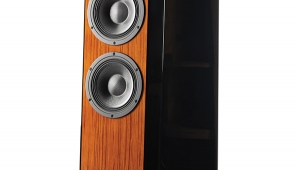| Columns Retired Columns & Blogs |
Hansen Audio Prince V2 loudspeaker
No matter how well you think you know the specialized world of high-end audio, there are always new companies, new technologies, and new products you just haven't gotten around to knowing yet.
 At the 2007 Consumer Electronics Show, one company scored a perfect triple on that score. I wandered into Hansen Audio's room, where I met Lars Hansen, heard the Emperor loudspeaker, and was impressed by Hansen's proprietary drivers. The Emperors sure sounded like the real thing, and Hansen himself was a very impressive man, but geeze louise, how likely was it that a company would come out of nowhere with not just one product but an entire speaker line of seven models? It would take a ton of chutzpah to think you could do all that overnight.
At the 2007 Consumer Electronics Show, one company scored a perfect triple on that score. I wandered into Hansen Audio's room, where I met Lars Hansen, heard the Emperor loudspeaker, and was impressed by Hansen's proprietary drivers. The Emperors sure sounded like the real thing, and Hansen himself was a very impressive man, but geeze louise, how likely was it that a company would come out of nowhere with not just one product but an entire speaker line of seven models? It would take a ton of chutzpah to think you could do all that overnight.
Lars Hansen has that, all right. He really is an audio polymath, creating drivers, constructing cabinets, and slaying audio shibboleths—and, oh yeah, designing a whole line of speakers that rewrite the rules.
As the months went by, Hansen and his sales manager, Wes Bender, managed to convince me that I had to audition the Hansen Audio Prince V2 ($39,000/pair). "It's the right size speaker for your room," Bender assured me. Good thing, too—in their boxes, the Princes—42" high by 14" wide by 20" deep—barely fit in my front hall.
Princes have long hands and many ears
I start with the drivers," said Lars Hansen. "First, I found a tweeter so good that even I couldn't improve upon it. The motor assembly has so much control over the soft dome that it reproduces the silences between notes every bit as well as the notes themselves. I designed the midrange and the woofer to have the most inert cones available today—we use a sandwich of three layers. The first layer is made from an epoxy based material that is comprised of many components and is infused with glass fibers. The second layer is Rohacel (one of the lightest materials known). The last layer is also an epoxy-based material but with a different mix than the first. This ensures they do not deform deform in reproducing the musical signal. The dustcaps and the underhung voice-coils—even the cross section of the surrounds—everything is consciously designed to eliminate colorations from being added to the wavepath.
"The cabinets are hand-molded of three layers of Hansen Composite Matrix, which contains up to six different components in each of the three layers, each of these layers has a different mix, a different thickness, and therefore a different density than the other two layers. After the Hansen Composite Matrix has been removed from the mould then a fourth layer, which is an acoustic damping material, is added to the inside [Hansen calls it "the cloaking device"—WP], and the final result is a shape that allows the widest dispersion and is extremely inert. If it was as simple as putting the drivers on a stick, that would be so nice, but every cabinet has an effect on dispersion, so I shaped the Prince very carefully, so it 'lets go' of the notes with the smallest possible effect on wave diffraction. It looks 'organic,' people tell me, but it is very calculated."
I asked Hansen what the Hansen Composite Matrix was made of. "I don't think it is useful to get any more technical than saying that it is a total of four different layers and each is made from an epoxy based material with numerous added components that took many months to get acoustically correct, and cost many hundreds of thousands of dollars to achieve" he said. "It's not rocket science—although there is rocket science in this loudspeaker."
Add to that a first-order crossover whose components are soldered, by hand, point to point with silver solder. "I use the midrange driver from around 100Hz out to 2500—and it remains pistonic for that whole range, so the woofer and tweeter can operate in their comfort zones, too. The big problem with first-order crossovers is that they frequently put too much strain on drivers at the lowest end of their range, but our drivers can handle that without any problem."
The Prince V2's enclosure has a port that fires out the front. Hansen cites the speaker's sensitivity as 87dB. The 25mm soft-dome tweeter is mounted on a "dispersion optimized" 6mm aluminum plate. The 7" (182mm) midrange driver and 10.5" (269mm) woofer certainly do not look ordinary. And the speaker, while not all that large, is heavy, as in well over 200 lbs each.
Put not your trust in princes
I initially installed the Prince V2s in my listening room with Krell's Evolution 202 preamplifier and Evolution 600 power amplifiers. Over time, I also used Conrad-Johnson's ACT2.2 preamplifier and Musical Fidelity's Nu-Vista 300 power amp. Sources included Ayre's C-5xe and Linn's Klimax DS. Cables were from Stealth, AudioQuest, and Shunyata Research, among others.
The Princes liked having room to breathe. In my listening room, I ended up with them facing straight ahead, their rear panels 56" from the front wall, their outside side panels 38" from the sidewalls, and their inside side panels about 77" apart. In those positions they opened up, delivering everything from staggering orchestral tuttis to completely convincing solo guitar.
Who made thee a prince and a judge over us?
My first impression was that the Prince V2 was indeed royalty in its presentation of the heft and weight of instruments. In fact, I began seeking out recordings I hadn't heard in a while, hoping to discover in them hitherto unheard felicities. I succeeded. One such disc was my copy of John Atkinson's 1997 live recording of guitarist John Abercrombie, pianist Marc Copland, bassist Peter Herbert, and Billy Hart. I was at the concert and my goodness, what a monster Hart was that day! He was playing a leased set of drums with a piccolo snare and the smallest bass drum I'd ever seen, but his sound was immense—and his beat impeccable.
- Log in or register to post comments




































